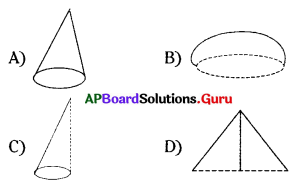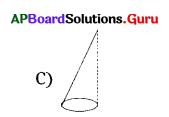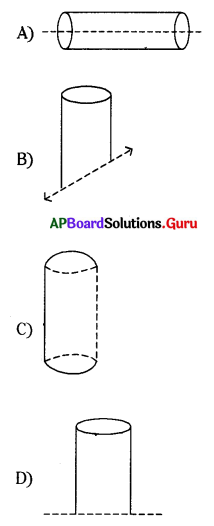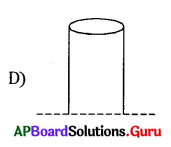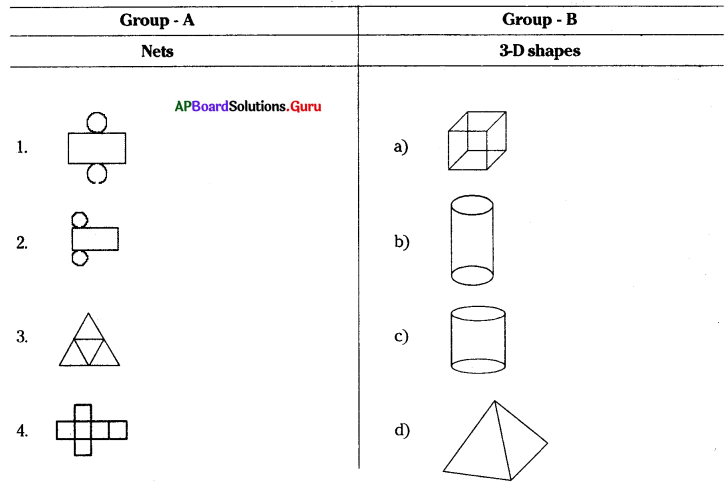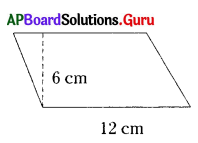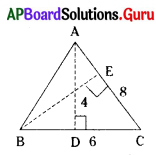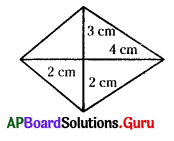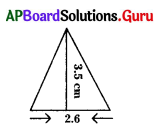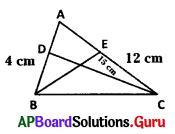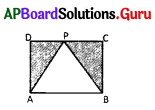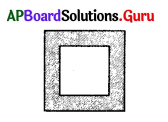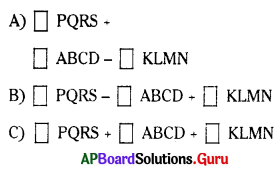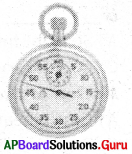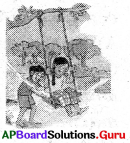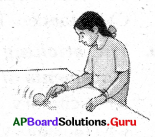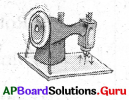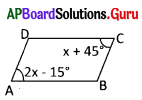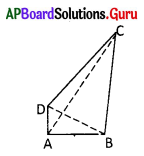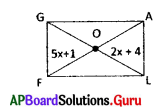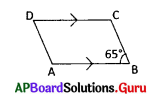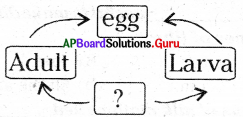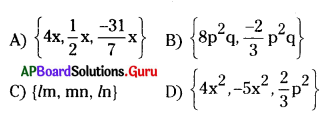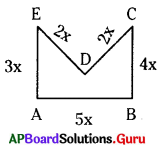Practice the AP 7th Class Science Bits with Answers Chapter 6 Weather and Climate on a regular basis so that you can attempt exams with utmost confidence.
AP State Syllabus 7th Class Science Bits 6th Lesson Weather and Climate with Answers
Choose the correct answer.
Question 1.
Weather changes
A) Week after week
B) Day after day
C) Within a short period
D) In any of the above time period
Answer:
D) In any of the above time period
Question 2.
Rain fall is measured by
A) Rain gauge
B) Water level in the ponds
G) Increase in the levels of ground water
D) None of the above
Answer:
A) Rain gauge
Question 3.
Maximum temperature of the day occurs generally in
A) The morning
B) Evening
C) Noon
D) After noon
Answer:
D) After noon
![]()
Question 4.
The quantity of. water vapour in air is
A) Temperature
B) Humidity
C) Climate
D) Weather
Answer:
B) Humidity
Question 5.
Humidity is measured by
A) Rain gauge
B) Anemometer
C) Wind guage
D) Hydrometer
Answer:
D) Hydrometer
Question 6.
The maximum and minimum temperature at a place is measured by
A) Lab thermometer
B) Six’s thermometer
C) Clinical thermometer
D) gas thermometer
Answer:
B) Six’s thermometer
Question 7.
Rain gauge is also called
A) Hydrometer
B) Anemometer
C) Udometer
D) None
Answer:
C) Udometer
![]()
Question 8.
Wind speed is measured by
A) Anemometer
B) Hydrometer
C) Speedometer
D) Udometer
Answer:
A) Anemometer
Question 9.
Tsunami in Andaman Nicobar occurred in
A) 2000
B) 2002
C) 2004
D) 2006
Answer:
C) 2004
Question 10.
Rainfall is measured in
A) mm
B) feet
C) yards
D) meters
Answer:
A) mm
Question 11.
Which of the following statements regarding weather is incorrect?
A) It is highly unpredictable.
B) It is measured on a day-to-day basis.
C) It is measured using factors like rainfall and humidity.
D) It remains the same throughout the week or even a month.
Answer:
D) It remains the same throughout the week or even a month.
![]()
Question 12.
Which of the following statements regarding humidity is correct?
A) It is the amount of rain received by a an area.
B) It is the amount of moisture present in the air of a given area.
C) It is measured by determining the . degree of heat of an area.
D) It is measured by determining the speed of wind in a given area.
Answer:
B) It is the amount of moisture present in the air of a given area.
Question 13.
Use the following information to answer the given question. The given table represents the weather data for a day of a place.

Based on the weather data, it can be inferred that the weather on the given day in the area is
A) cold and humid
B) hot and humid
C) cold and dry
D) hot and dry
Answer:
A) cold and humid
Question 14.
The minimum temperature of the day is measured during what time period of the day?
A) Early morning
B) Late night
C) Afternoon
D) Evening
Answer:
A) Early morning
Question 15.
A place with a mean temperature of 38 °C that receives high rainfall has what type of climate?
A) hot and dry
B) hot and wet
C) cold and dry
D) cold and wet
Answer:
D) cold and wet
![]()
Question 16.
Rajasthan receives very little rainfall and its mean temperature is very high. The climate of Rajasthan is
A) hot and dry
B) hot and wet
C) cold and dry
D) cold and wet
Answer:
A) hot and dry
Use the following information to answer the given questions from. 17 to 21.
The given table gives the climate data for Srinagar and Thiruvananthapuram.
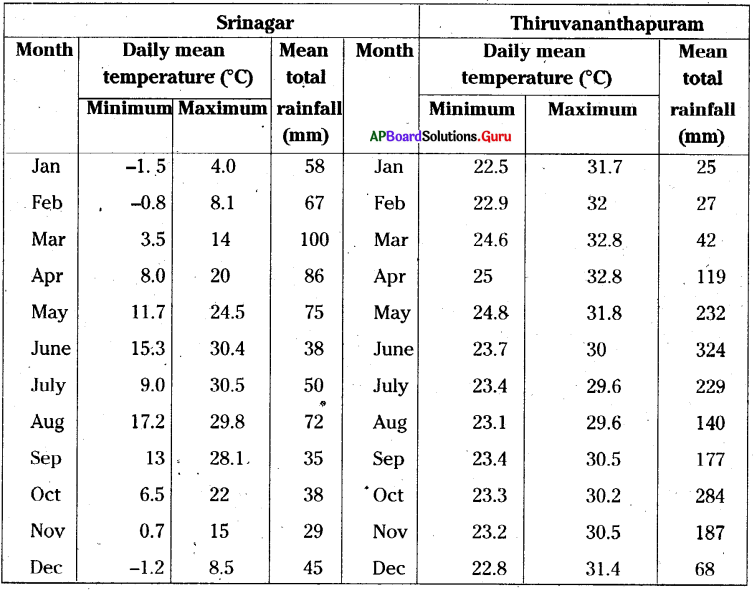
Question 17.
The climate of Srinagar is
A) hot and dry
B) hot and wet
C) cold and dry
D) cold and wet
Answer:
C) cold and dry
Question 18.
The climate of Thiruvananthapuram is
A) hot and dry
B) hot and wet
C) cold and dry
D) cold and wet
Answer:
B) hot and wet
Question 19.
In which month both the cities are getting cool and dry?
A) December
B) January
C) February
D) November
Answer:
B) January
![]()
Question 20.
In which month Thiruvananthapuram is having moderate climate?
A) December
B) January
C) February
D) November
Answer:
B) January
Question 21.
What is the reason behind Srinagar for getting more rainfall during March?
A) Dissolving of glaciers
B) Due to cool breeze
C) Due to hot waves
D) Heavy fog
Answer:
B) Due to cool breeze
Question 22.
In Six max-min thermometer magnet is used
A) to take readings
B) to make indicators at original positions
C) to keep thermometer safe
D) to maintain accuracy
Answer:
B) to make indicators at original positions
Question 23.
Farmers measure rainfall based on
A) wetness of the soil
B) dryness of the soil
C) humidity of the air
D) dryness of the air
Answer:
A) wetness of the soil
![]()
Question 24.
PADUNU means
A) rainfall is insufficient
B) rainfall is sufficient
C) rainfall is heavy
D) salinity of the soil
Answer:
B) rainfall is sufficient
Question 25.
Moving back of ocean and making sounds of birds indicates
A) Cyclone
B) Rain
C) Hailes
D) Tsunami
Answer:
D) Tsunami
Question 26.
Anemometer is useful to measure
A) speed
B) direction
C) speed and direction
D) none of these
Answer:
C) speed and direction
Question 27.
If the depth of water in rainguage is 1 cm it indicates the rainfall
A) 10 mm
B) 1 mm
C) 10 mm
D) 100 mm
Answer:
A) 10 mm
![]()
Question 28.
During summer morning we will get
A) cool breeze
B) hot waves
C) cool and hot waves
D) thunder storms
Answer:
A) cool breeze
Question 29.
In summer if you are in coastal area, you feel
A) cool
B) sweaty
C) hot
D) sweaty and hot
Answer:
D) sweaty and hot
Question 30.
The weather of Kolkata is
A) humid
B) mild
C) dry
D) cold
Answer:
A) humid
Question 31.
The weather of Rajasthan is
A) humid
B) mild
C) dry
D) cold
Answer:
C) dry
![]()
Question 32.
The following is effecting the life of human beings
A) Temperature
B) Rain
C) Wind speed
D) All the above
Answer:
D) All the above
Question 33.
“Sky may be cloudy for the next two days”. It is
A) weather report
B) weather forecast
C) both A and B
D) none of the above
Answer:
B) weather forecast
Question 34.
42°C maximum temperature recorded at Rentachintala it is a
A) weather report
B) weather forecast
C) both A and B
D) none of the above
Answer:
A) weather report
Question 35.
What is this instrument?
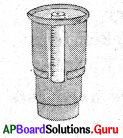
A) Anemometer
B) Thermometer
C) Hygrometer
D) Rainguage
Answer:
D) Rainguage
![]()
Question 36.
It shows
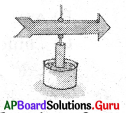
A) temperature direction
B) rain direction
C) wind direction
D) tsunami direction
Answer:
C) wind direction
Question 37.
The following city having less humidity
A) Visakapatnam
B) Vijayawada
C) Hyderabad
D) Rajamundry
Answer:
C) Hyderabad
Question 38.
How many years of average temperature and rainfall is considered as climate of a place?
A) 10 years
B) 25 years
C) 50 years
D) 100 years
Answer:
B) 25 years
Question 39.
The quantity of water vapour in air is called
A) rain
B) snow
C) hails
D) humidity
Answer:
D) humidity
![]()
Question 40.
Rainfall of a particular place is expressed in
A) centimeters
B) kilometers
C) grams
D) litres
Answer:
A) centimeters
Question 41.
This figure shows
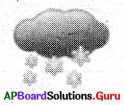
A) Rain
B) Thunder rain
C) Stroms
D) Hailes
Answer:
D) Hailes
Question 42.
Study of rainfall weather forecast is done by
A) Indian Meterio Roids Department
B) Indian Geological Department
C) Indian Meteorological department
D) None
Answer:
C) Indian Meteorological department
Question 43.
In this place the weather is hot and dry
A) Bengaluru
B) Delhi
C) Kolkata
D) Rajasthan
Answer:
D) Rajasthan
![]()
Question 44.
We used this to measure the day temperature
A) Six maximum minimum thermometer
B) Anemometer
C) Clinical thermometer
D) Udometer
Answer:
A) Six maximum minimum thermometer
Question 45.
This symbol indicates

A) Rainfall
B) Heavy rainfall
C) Hailes
D) Thunder stroms
Answer:
D) Thunder stroms
Question 46.
Which one of the following statements regarding weather is incorrect?
A) It is highly unpredictable.
B) It is measured on a day-to-day basis.
C) It is measure of using factors like rainfall and humidity.
D) It remains the same throughout the week or even a month.
Answer:
D) It remains the same throughout the week or even a month.
Question 47.
Which one of the following statements regarding humidity is correct?
A) It is the amount of rain received by an area.
B) It is the amount of moisture present in the air of a given area.
C) It is measured by determining the degree of heat of an area.
D) It is measured by determining the speed of wind in given area.
Answer:
B) It is the amount of moisture present in the air of a given area.
![]()
Question 48.
Which of the following is measured with this?
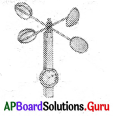
A) Speed of wind
B) Direction of wind
C) Humidity in the air
D) Both A & B
Answer:
D) Both A & B


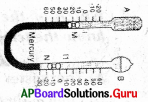

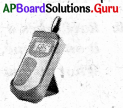

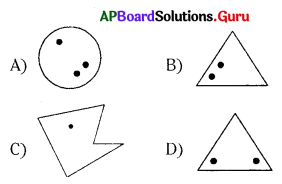

 ?
? ?
? ?
?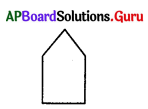 ?
? ?
? is
is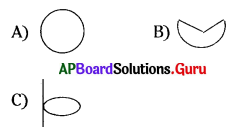


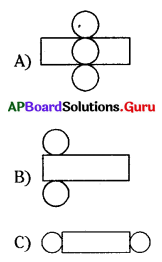
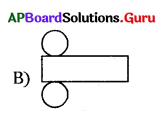
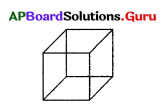
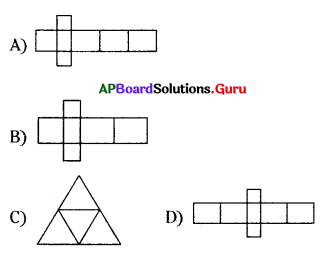
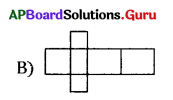
 ?
?